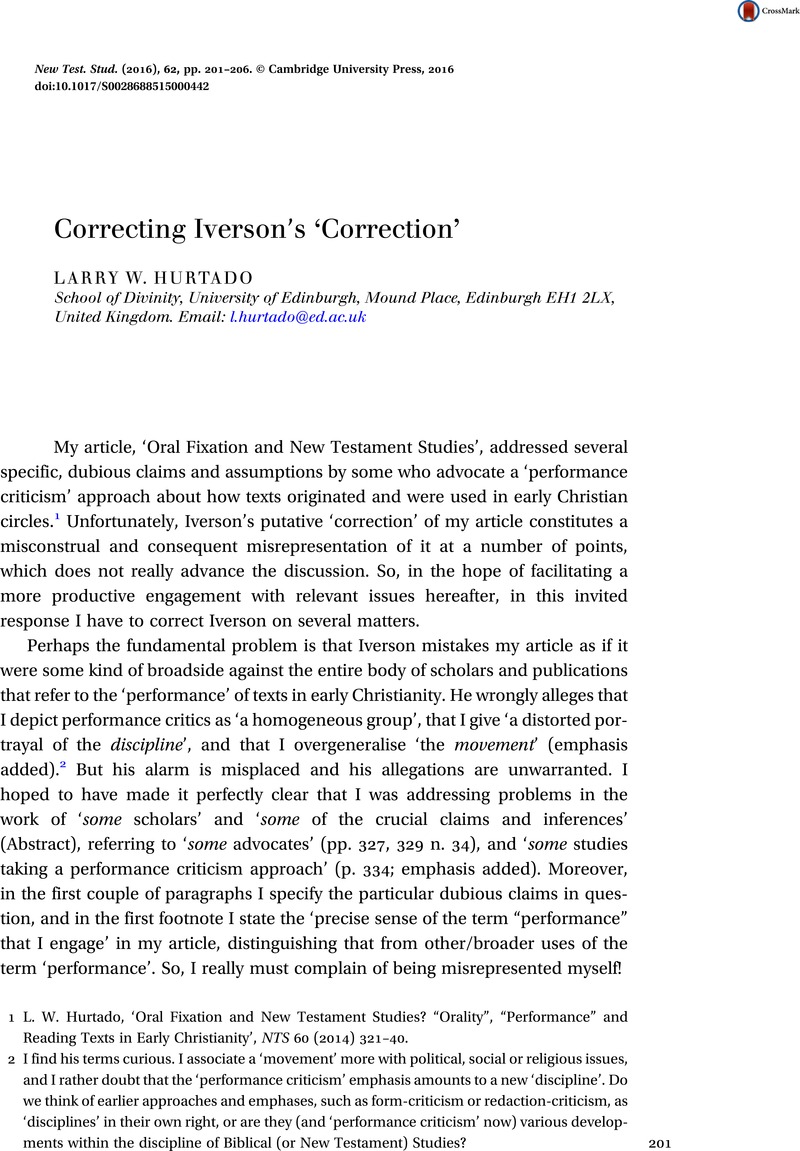Published online by Cambridge University Press: 29 February 2016

1 Hurtado, L. W., ‘Oral Fixation and New Testament Studies? “Orality”, “Performance” and Reading Texts in Early Christianity’, NTS 60 (2014) 321–40CrossRefGoogle Scholar.
2 I find his terms curious. I associate a ‘movement’ more with political, social or religious issues, and I rather doubt that the ‘performance criticism’ emphasis amounts to a new ‘discipline’. Do we think of earlier approaches and emphases, such as form-criticism or redaction-criticism, as ‘disciplines’ in their own right, or are they (and ‘performance criticism’ now) various developments within the discipline of Biblical (or New Testament) Studies?
3 K. Milnor, Graffiti and the Literary Landscape in Roman Pompeii (Oxford: Oxford University Press, 2014) 278.
4 I discuss these features further in The Earliest Christian Artifacts: Manuscripts and Christian Origins (Grand Rapids: Eerdmans, 2006) 177–85.
5 Contra Iverson, I have no ‘rigid’ view about whether readers stood or sat. Parker's insistence that readers were ‘always seated’ (cited by me, p. 334) applied to the reading of texts in group-settings such as dinners and circles gathered for the reading of literary texts. I acknowledge as a positive contribution Iverson's references to readers apparently standing for the task in synagogues (e.g. Luke 4.16). But, of course, the earliest settings of the Jesus-movement seem to have been homes and other such venues, not the dedicated spaces comprised by synagogue structures. So, it remains more likely that those who read in earliest Christian circles were typically seated. But the posture issue is not really crucial. Nor is it really consequential that in the painting that I cite (p. 335), where a seated person is reading to a group, the reader seems to be pointing to a passage in the opened roll. The point is that he holds and reads from a written text, and is not reciting it from memory or behaving like an actor.
6 See e.g. the Roman-era visual depictions of ‘Der isoliert Lesende’, in T. Birt, Die Buchrolle in der Kunst: Archäologisch-antiquarische Untersuchungen zum antiken Buchwesen (Leipzig: Teubner, 1907) 155–71.
7 As an illustration, note the paragraph markers inserted by an early reader/user of P.Oxy. 654 (a personal copy of the Gospel of Thomas from the third century ce). Also, in another publication I note variants in Acts that seem to reflect close exegetical activity by early Christian readers: ‘God or Jesus? Textual Ambiguity and Textual Variants in Acts of the Apostles’, Texts and Traditions: Essays in Honour of J. Keith Elliott (ed. P. Doble and J. Kloha (Leiden: Brill, 2014) 239–54.
8 Granted, the English word ‘recitation’ derives from the Latin recitatio, which typically means the reading aloud of a written text. But Iverson uses the English term, not the Latin one.
9 A ready example is 1 Cor 3.21–3, with the rhyming words (e.g. Παῦλος/Ἀπολλῶς, Χριστοῦ/Θεοῦ), repetition of words with same initial letter (Κηφᾶς/Κόσμος), and the drum-beat of repeated εἴτε phrases.
10 For example, I reckon that we know of some 200 or more books composed in early Christian circles in the first three centuries ce. See e.g. C. Moreschini and E. Norelli, Early Christian Greek and Latin Literature: A Literary History, vol. i: From Paul to the Age of Constantine (trans. M. J. O'Connell; Peabody, MA: Hendrickson, 2005).
11 H. Y. Gamble, Books and Readers in the Early Church: A History of Early Christian Texts (New Haven: Yale University Press, 1995) remains essential on the heavy investment in writings in early Christianity. I have discussed the early Christian preference for the codex in The Earliest Christian Artifacts, 43–93, with copious references to earlier scholarly work.